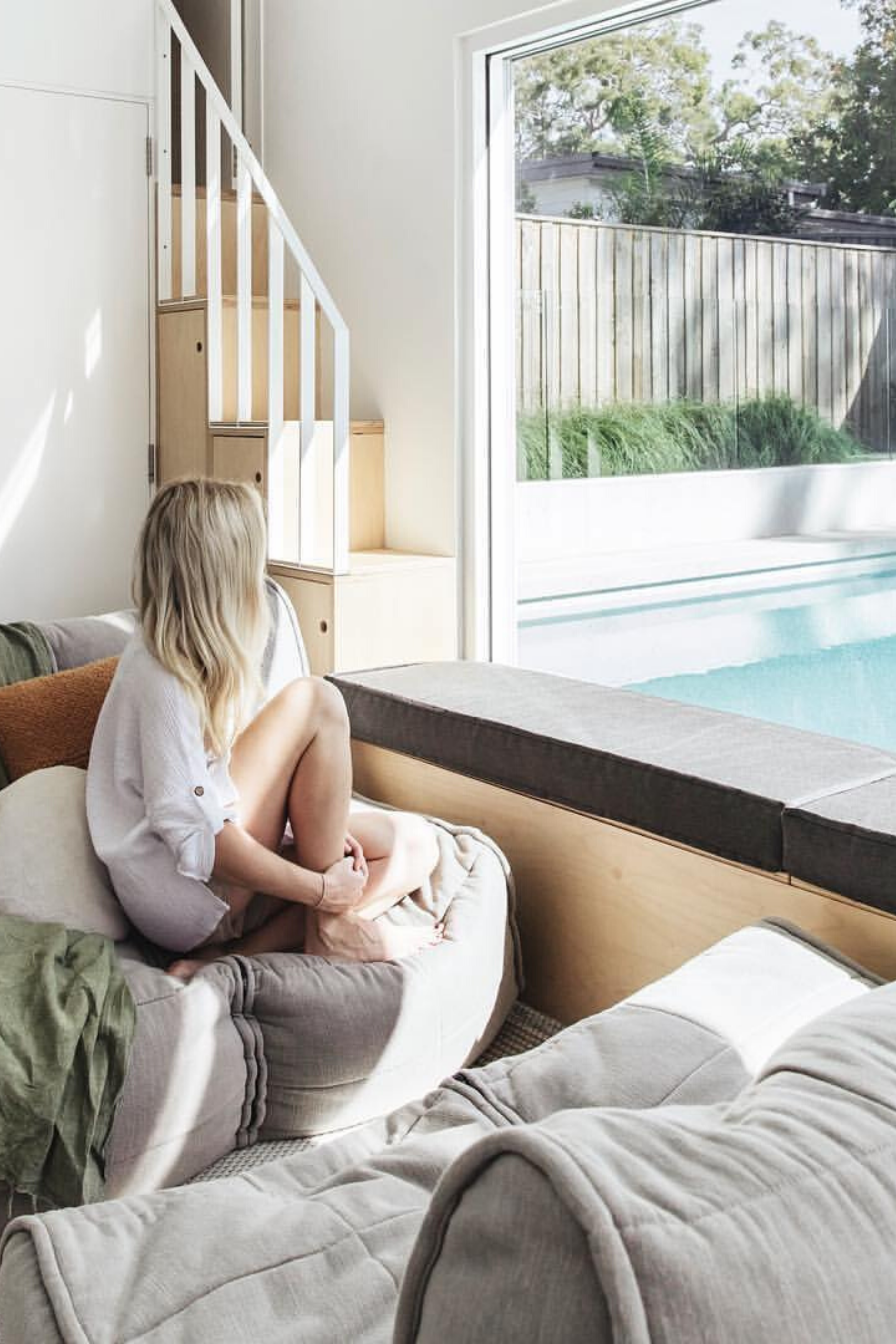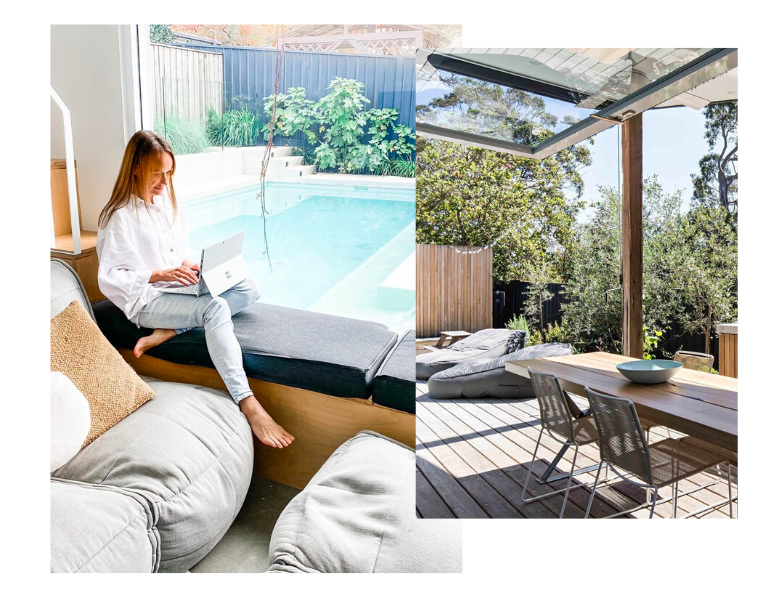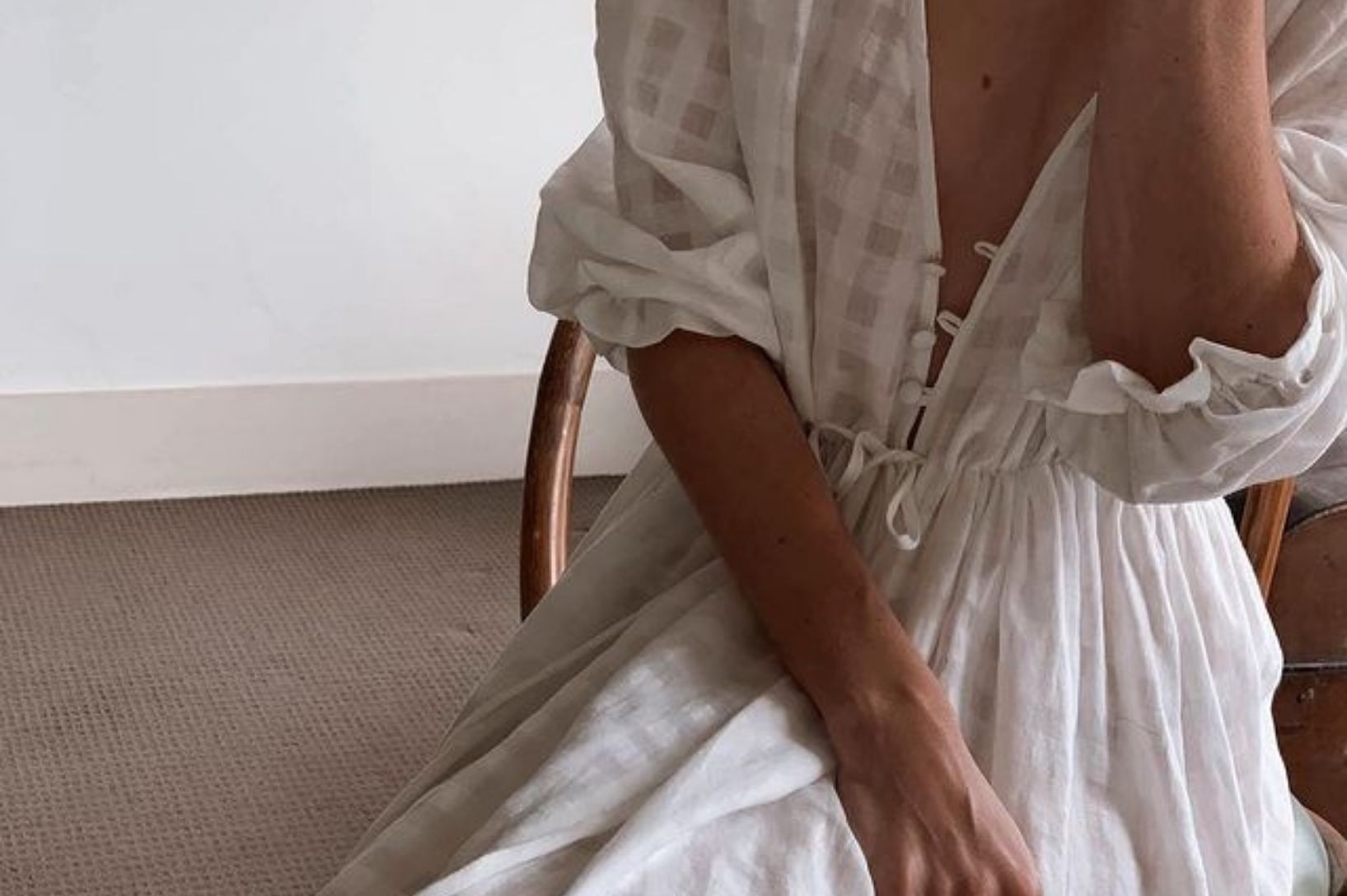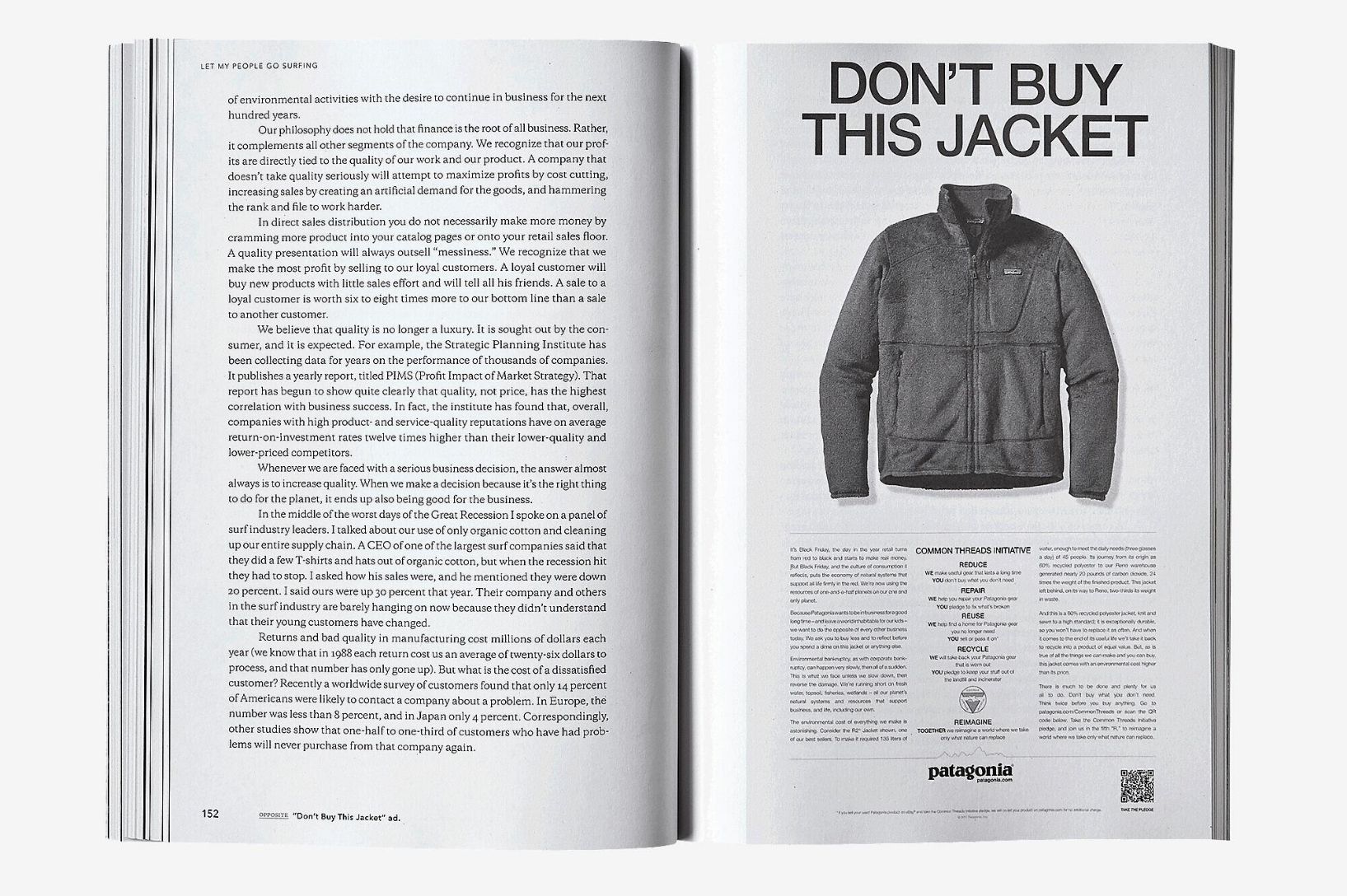Release your material mindset: shifting from wanting to contentment
Marnie Prowse from Tiny Haus is a recovering consumerist who shares how to release your material mindset, to shift from wanting to contentment. Through self-reflection and experimentation, she saw the negative habits she had built and the impacts on her family. From that moment she decided to make long-lasting changes in my life. We encourage you to try these out too.

By Marnie Prowse of Tiny Haus
Image by The Palm Co.
“I need this. When I get this, I’ll be happy; then I’ll be content.”
This conversation often played out in my mind or with anyone who would listen. Oh, the justifications, I had many for spending my hard-earned money or dollars I was yet to earn – hello credit card! I would buy, and yes I felt an initial thrill—I’d strut around my new shiny thing. However, the shine would soon wear off, and I was inevitably off to look for the next thing to buy my ‘happiness’.
Yet, my credit card balance wasn’t making me happy; in fact, it was making me anxious just thinking about it. I worked long, stressful hours to pay for the stuff. I spent my down-time aimlessly scrolling when I should have been talking to my husband or playing with my daughter. When I took an honest look at my belongings and the need for more, it was consuming me. It was defining who I was.
Sound familiar? From a recovering consumerist, I’d like to share with you my journey to release my material mindset, to find contentment. Through self-reflection and experimentation, I saw the negative habits I had built and the impacts on my family and me. From that moment I decided to make long-lasting changes in my life. I encourage you to try these out too.
1. Take control of social media
Social media can be an incredible platform; it gives every person a voice and connects people. But let’s be real; it can also be downright consuming. I asked myself this question “how does social media make me feel?” My first answer “insecure”. I was comparing myself to the polished reels of the people I followed; the clothes, the holidays, and the perfectly-styled homes. I felt as if I was never good enough.
For one month, I turned off all social media. And, while I was at it, I unsubscribed from the many email subscriptions I received daily. The results:
- I had more free time. I wasn’t aware just how much time I was spending on social media – Yikes! Not only is it the time scrolling, but taking perfect images, writing witty captions, checking for likes and comments
- I freed up headspace by not using energy worrying about what others had
- I felt more confident in myself.
- I felt gratitude for what I did have
After my month-long sabbatical, I knew when I turned my social back on, I was only going to use them for good. I undertook a social media cleanse. I unfollowed accounts and left groups that:
- did not add value to my life
- generated cravings for more
- made me feel I was missing out
- drove my insecurities
The accounts and groups I follow; inspire me, they educate me, and they enrich my life. I took back control of my socials.
2. Be present in the moment
Often I’d find my mind wandering when I was with family & friends. I’d be thinking about the worry of life’s problems, such as the dishes in the sink, the email I forgot to send or what I was going to wear on the weekend. I was listening with one ear and not contributing to the conversation. I was missing out on the real person right in front of me.
So, for one month, I made a very conscious decision not to let any external distractions or thoughts get in the way of what was happening right in front of me. I would focus entirely, I would listen intently, and I would be curious. The results:

- When I was with my daughter, I put everything else aside, we played, and we laughed. Did she always smile this much? She has a beautiful smile
- I talked through issues with my husband, and we connected like we hadn’t in years
- I was learning new things because I was genuinely listening
- I felt joy in the moments that could be described as insignificant
3. Do something I love
When I moved out of home, my responsibilities immediately grew. I had to feed myself. I had to clean. I had to wash clothes, fold and iron. I had to work to earn money to pay bills. And as I got more stuff, so my responsibilities grew. I felt like I was selfish if I organised something for myself —I always had more important things to do. If I did do something for myself, the guilt would prevent me from enjoying the experience. I struggled to remember a time that I did something that I loved and loved the experience.
So, for one month, I would practise yoga twice each week. I blocked out uninterrupted time to completely embrace myself in the experience. The results:
- It supported me to stay present
- I felt less stressed
- I felt an inner sense of peace and calm
- I was more aware of my feelings
I used to love practising yoga, yet I hadn’t done it in years. I was too busy, and I didn’t make the time. When I took it back up, I realised—I missed it. When I allowed myself to let go of the guilt, I realised that practising self-care was making me a better person. Not only was I healthier and more motivated, but I was also a warmer person to be around.
4. Be bored
I squeezed through the train doors as they closed, I found myself one of the last seats, I sat down, and I reached into my bag. Moments passed, and my hand started searching frantically. I picked up my handbag, and I gazed into my bag—my gasp was audible to everyone on the carriage—I forgot my phone. Nooooooo. It was too late to get off and run home to get it. I had the entire trip without my phone. I had to sit there, just with my thoughts. I put my head up, and I looked at the people in the full carriage, I was the only person (unintentionally) who wasn’t looking at a screen. It got me thinking; when was the last time I let my mind wander? When was the last time I allowed myself to be bored? When did I last allow myself to dream? I couldn’t remember.
So for one month, three days each week when I caught the train, and I wouldn’t look at my phone—no news, no emails—it would stay in my bag. The results:
- I was productive. I was preparing my (hand-written) to-do list, I planned for meetings, and I outlined my tasks
- I was creative. I had streams of ideas for businesses, books, blogs, our vegetable garden and more
This experiment tested me the most. But the results were the most visible. I didn’t feel as if I was missing out on anything – if anything, I felt more in control and optimistic about the future.
“We have been conditioned for most of our lives to want more. So how do we make a change for good?”
I took control of social media.
I was present.
I was doing something I loved.
I put the phone down and allowed myself to be bored.
All of these things cost me no money. Yet, I noticed that I was laughing more. I was more connected to my daughter and husband. I felt more at peace with myself, and my awareness of what other people thought of me was fading. For that month, I felt a levelled sense of peace and happiness. I wasn’t craving for more—I was content.
We have been conditioned for most of our lives to want more. So how do we make a change for good? How do we maintain this feeling of contentment?
5. Commit to change:
- Write it on a piece of paper, stick it to your fridge
- Tell your partner, friend, your mum
Explain the mindset you are shifting and how you will be going about it. Hold yourself accountable.
6. Develop New Habits:
Fifteen years ago I tried to give up smoking—I knew it was terrible for me, my friends and family hated it—I just had to give it up, yet it wasn’t that easy. Two years passed and about seven attempts later, I kicked it for good. It took different approaches, it took various interventions, it took some serious conversations with myself. I think I needed to go through these seven attempts to learn—so I could finally kick this habit for good. And I did it.
Is shopping the same as smoking? Well not exactly, but there sure are some of the same addictive qualities. The reasoning, the manic behaviour, the deep down knowing that it isn’t doing us any good—yet we continue. And like smoking this habit isn’t easy to break.
The experiments gave us a taste of what contentment can feel like – hold on to this feeling; it’s the first step towards longer-lasting change.
Here are my tips from moving away for breaking those tempting habits:
- When you walk in the door, put your phone away. Set a time to look at your phone, set a time limit and have a purpose on what you want to get out of this time
- Rather than cruising the shopping mall, go for a walk in nature
- Make a concerted effort to connect to people on a deeper level, rather than talking about clothes
- Create: draw, write, paint, make music, garden, dance, create a new outfit from your existing wardrobe
There are times when I find myself comparing myself to others, making a bad choice, and I see myself slipping back into old habits. But when I catch myself doing this, I’m aware. I don’t beat myself up, yet I’m patient with myself. Because when I’m aware of these failings, it means I’m maturing. I’m learning what triggers me. I’m learning which behaviours and actions aren’t serving me. Having the courage to get back on track and keep on going is the most significant step to long-lasting change. And with this in mind, I say take this all in your stride bit by bit. You’ve got this!
If these helpful tips from the incredible Marine Prowse of Tiny Haus have inspired you to release your material mindset, there’s plenty more where that came from over on her website. And If you sign up to her newsletter today, you’ll receive her amazing ebook, Tiny Haus Lifestyle: A Guide to Living Simply. Inside it you’ll find more tips and tricks to help you become a more mindful and present by addressing the design and style of your house, the food you eat, the technology you consume, the stuff you own, and how you look at mindfulness, your community and the planet.


